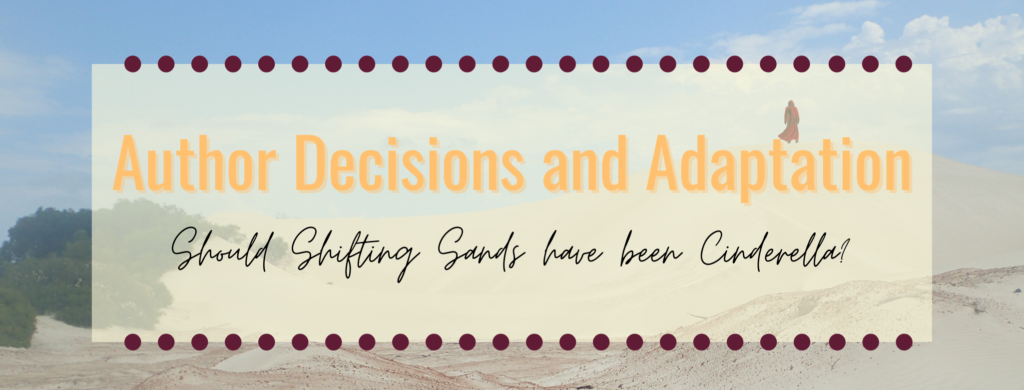There are countless online articles and blog posts about how to build an audience as an author. Before developing my author self, I did content analysis on more than 50 of these articles to see what advice was out there and what elements were most important to include. Building an author brand was one of the top results, featuring in 35% of cases. Before being somewhat disrupted by travelling home and the release of Shifting Sands, I wrote last month about what an author brand is and why we care about it, and now I’m finally getting around to how you do it! How do you even begin to create an author brand?
Author branding from a reader’s POV
Just as we may rely on cues given by book covers or familiarity with genre, Collange and Puhl (2019) suggest that an author name works kind of like a contract or promise. It tells the reader what to expect, both in terms of quality and content. They also suggest that an author name should bring feelings of a “magician”, or enchanter. I really enjoy this idea, in part because of my fantasy roots, but also because of how it ties to the god-like author figure constructing worlds. The author name promises immersion and escape.
The expectation highlighted by the Collange and Puhl paper that I found most intriguing is that the author name should inspire feelings of friendship. An author should commit to the author/reader relationship, building trust and attachment. For my research, this seems especially interesting because it seems like a contradiction. The author must, on the one hand, appear to be that distant, god-like creator. They should be embroiled in their art, not selling out to be commercial or brand-like. And yet, they should be a friend. Distant, but not distant. I imagine that’s part of the reason so many authors struggle with author branding and the balance of letting readers into their worlds while trying to maintain authority over them. But this drifts slightly from the current discussion, so I’ll move on (but if anyone wants to talk about this, I’m so there!).
How to create your author brand
The underlying question at the heart of personal branding is, “What makes you special?”
Philbrick and Cleveland, 2015
The Philbrick and Cleveland article quoted above lists six steps to building your personal brand: introspection, understanding the existing brand, developing a mantra, crafting your physical footprint, crafting your digital footprint, and communicating your message. While this was not specifically targeted towards authors, these steps align with criteria often set in advice blogs and articles about author branding. Naturally, I like combining my research side with my author side – you could even say that’s part of my personal brand! – so why not do the same here?
1. Introspection
Hello, it’s time to have a close look at yourself. Who are you? What do you care about? What makes you stand out? Belinda Griffin, writing here for The Creative Penn, echoes this idea across a few different points. First, develop your voice. This is all about reflecting on how others see you and how you want to be seen. I know for myself, I naturally fall into this generally upbeat and often quirky voice online. I want my part of the internet to be a relatively happy one and so this is what I put across online.
Griffin further talks about the need for a USP, or Unique Selling Point, as an author. What do you bring to the table that other authors might not? Do you capture character voices well, or plot like a master? Do your books tackle difficult themes in a child-friendly way? Or is your writing filled with sensual elevator scenes that would make a priest blush? (Side note: Please don’t be both of the last questions at once!) This can be difficult to balance – after all, we all tend to use what we’re already familiar with to decide if we want to go for a book – but working out what makes you unique can help you carve out the space for your reader community.
2. Understanding the existing brand
As mentioned in the previous author branding post, we all probably have a brand, whether we mean to or not. Those who interact with us will already have built up an idea of who we are, based on the way we conduct ourselves and the ways we are connected. Philbrick and Cleveland suggest that anyone concerned about their personal branding should conduct an audit. Examine your online presence and see what impressions you’re giving out.
An important point made in the Philbrick and Cleveland article, from my point of view at least, is that your personal brand is made up of both your existent branding and that of your profession. How you connect to others is key. As I’ve mentioned a few times, readers already have expectations for authors. The world sees us in a certain way, even if that’s an illusion. From my experience, most authors seem to embrace much of the profession’s author persona – introversion, an obsession with books, imagination, etc – but this doesn’t mean you have to. Your USP could be that you’re a different type of author. Just remember that the profession’s branding also influences yours and work out how you want to handle that. Believe me, fantasy authors have been dealing with the collective branding for a while!
3. Developing a mantra
Writing for Forbes, Megan Marrs describes the personal brand mantra as the foundation of your brand. It’s the quick, simple statement that sums up who you are and what you’re bringing to the table. As someone who likes screenwriting, I like to think of this almost as a logline – a short summary to sell your work (in this case, you) to your audience. You want a one sentence mantra that you can use to clearly explain who you are and what you do, giving you direction and your reader clarity. Mine? I’m a writer who balances writing fantasy with researching authorship and book culture. Does this sound familiar? If you follow me on Facebook or Twitter, you’ll see it’s basically my bio for both. Hey, a shortcut to writing the dreaded author bio!

4. Crafting a physical footprint
This section is obviously the part of the Philbrick and Cleveland article that relates most to business culture rather than author branding, but there are still helpful tips that can be applied. It’s all about appearing professional in the workplace, through both personal grooming and cultivating your space. Translated for author branding, I would switch this out to the author photo/any in person appearances and the work you produce.
For both the author photo and any physical appearances, looks are unfortunately important. You can turn up with dirt under your fingernails and a stain on your shirt if you like, but that’s obviously going to communicate certain things to your readers whether you’d like them to or not. You want your appearance to fit in with your author brand. I am not naturally an image-based person – I would rather write down my thoughts and feelings than try to show them through a photo, but unfortunately social media prefers a good image. So, I did what I do best, researching whatever tips there were online about author photos and sought out some of my favourite authors to see what theirs looked like. I found this post by Phil Stamper-Halpin particularly helpful for alleviating some of my author photo-anxieties.
Most readers aren’t going to see your actual author workspace unless you decide to share pictures with them (which isn’t a terrible idea, given social media’s love for pictures). What they are going to see, however, is your output. An author’s workplace is in words, through blog posts and tweets to short stories and novels. You want these to be the best they can be. Even more so, you want them to fit your author brand. All that introspection from step one should help here – what is your voice and what are you saying? The aim is to produce something professional, consistent, and you.
5. Crafting a digital footprint
When we think of branding, most often we’ll think of the aesthetics. Logos, colour palettes, so on and so forth. Crafting the digital footprint ropes in a lot of these aspects. Once again, consistency is king! If you decide that your are John J. John on Twitter, make sure you’re also John J. John in your books, on Facebook, and whatever other platforms you link to your author self. If you use a particular colour palette on your website, see if you can use that colour palette elsewhere as well. In my case, I use the same filter for 99% of my images across all the Kate Stuart Author platforms and drew my colour palette from the main image I use on my site. Even the covers of Shifting Sands draw from shades in that colour palette.
Once you’ve got the aesthetics covered, the time comes to start expanding. An author, and particularly an indie or self-published author, needs to grow their digital footprint to grow their reader community. This won’t help if you only ever tell the same five Facebook friends about your work. Instead, try blogging, engaging in established communities online, cross-posting… Anything that is relevant to your author brand and will help you reach a wider audience. Engage regularly to keep building.
When building your digital footprint, don’t forget that your profession – in this case, as an author – is part of your personal brand. Aligning yourself with others can build trust, encourage new readers to give you a try, and grow your digital footprint and thus your author brand. You do want to be careful with this though! Make sure to check the people you’re aligning yourself with do work to benefit your brand. You don’t want to find that you’ve accidentally given people the impression that you support one belief through *cough* liking a tweet in a “senior” moment *cough* and then reveal that you’re not the person your followers think you are. Be clear, consistent, and honest about what you believe and build a network that supports this. As Philbrick and Cleveland note, regular audits help to ensure your online footprint works for your author branding.
6. Communicating your message
The final step mentioned by Philbrick and Cleveland really seals in the importance of consistency and clarity. Everything to do with your professional author self should align. Linking back to Collange and Puhl, an author name needs to establish trust. Why should a reader listen to you if you seem like you’re all over the place? Even worse, inconsistency could make it seem like you were lying previously, thus implying that you’re inauthentic. It’s a tricky balance to manage – being a brand, authentic, and a person with faults – but your author brand relies on you to do your best with this.
Over to you
What a monster post! I’m really enjoying writing about building an author brand, both because of the subject itself, but also because I can see how this ties into my research. The clashes between the different needs of an author brand play a part in how my author self is being constructed fascinates me, especially as I can see the same thing being played out by much bigger authors. The next post I have planned in this author branding series looks at how the process of constructing an author brand has affected me – what works for me and what doesn’t – but writing this post has made me wonder if it’s worth adding another one to the list, moving this trio into a quartet. So, dear reader, would you like to hear more about my content analysis and some of the elements needed to build an author brand?
Who are some of your favourite authors and what do you like about their branding? I have a few I could name!




Comments
Comments are closed.